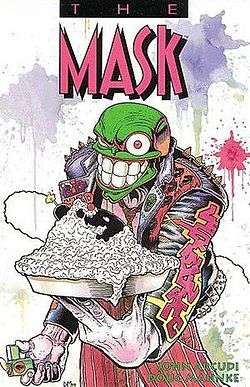
Gridlock'd
Gridlock'd is a 1997 American comedy-drama film written and directed by Vondie Curtis-Hall and starring Tupac Shakur, Tim Roth, Lucy Liu, and Thandie Newton. It was the directorial debut of Curtis-Hall, who also has a small role in the film. The film's opening was relatively low, despite critical acclaim; its opening weekend netted only $2,678,372 and it finished with a little over $5.5 million. The film paid tribute to star Tupac Shakur, who had been murdered four months prior to the film's release.
Plot
Set in Detroit, Gridlock'd centers around heroin addicts Spoon (Tupac Shakur), Stretch (Tim Roth) and Cookie (Thandie Newton). They are all in a band together in the spoken word genre. They go by the name of Eight Mile Road, with Cookie on the vocals, Spoon on the bass guitar (plus secondary vocals), and Stretch on the piano. Spoon and Stretch decide to kick their habit after Cookie overdoses on her first hit. Throughout a disastrous day, the two addicts dodge police and local criminals while struggling with an apathetic government bureaucracy that thwarts their entrance into a rehabilitation program.
Gridlocked (2015 film)
Gridlocked is a 2015 Canadian action-thriller film directed by Allan Ungar and co-written by Ungar and Rob Robol. The film stars Dominic Purcell, Cody Hackman, Danny Glover, Stephen Lang, Trish Stratus, Vinnie Jones, and Saul Rubinek. The film had its world premiere at Fantastic Fest on September 26, 2015.
Cast
Plot
Former SWAT leader David Hendrix (Dominic Purcell) and arrogant movie star Brody Walker (Cody Hackman) must cut their ride-along short when a police training facility is attacked by a team of mercenaries.
Production
Principal photography on the film began July 7, 2014 in Toronto, Ontario and lasted for five weeks.Cuba Gooding, Jr. was previously set to play the lead role, but he was replaced by Purcell. The majority of filming took place in an abandoned meat packing plant, which the producers turned into a studio for the duration of the shoot.

Mask
A mask is an object normally worn on the face, typically for protection, disguise, performance, or entertainment. Masks have been used since antiquity for both ceremonial and practical purposes. They are usually worn on the face, although they may also be positioned for effect elsewhere on the wearer's body. In parts of Australia, giant totem masks cover the body, whilst Inuit women use finger masks during storytelling and dancing.
Etymology
The word "mask" appeared in English in the 1530s, from Middle French masque "covering to hide or guard the face", derived in turn from Italian maschera, from Medieval Latin masca "mask, specter, nightmare". This word is of uncertain origin, perhaps from Arabic maskharah مَسْخَرَۃٌ "buffoon", from the verb sakhira "to ridicule". However, it may also come from Provençal mascarar "to black (the face)" (or the related Catalan mascarar, Old French mascurer). This in turn is of uncertain origin — perhaps from a Germanic source akin to English "mesh", but perhaps from mask- "black", a borrowing from a pre-Indo-European language. One German author claims the word "mask" is originally derived from the Spanish más que la cara (literally, "more than the face" or "added face"), which evolved to "máscara", while the Arabic "maskharat" - referring to the buffoonery which is possible only by disguising the face - would be based on these Spanish roots. Other related forms are Hebrew masecha= "mask"; Arabic maskhara مَسْخَرَ = "he ridiculed, he mocked", masakha مَسَخَ = "he transfomed" (transitive).
List of Forgotten Realms deities
This is a list of Forgotten Realms deities. They are all deities that appear in the fictional Forgotten Realms campaign setting of the Dungeons & Dragons role-playing game.
Forgotten Realms vs. core D&D
The deities of other Dungeons & Dragons campaign settings, including those of the default (or "core") setting for the Dungeons & Dragons game, are not generally a part of Forgotten Realms. However, there is some overlap, especially among the deities of nonhuman races. Lolth, the principal deity of the drow in the Forgotten Realms, is specifically described as being the same deity as Lolth in other campaign settings. No mention is made as to whether other deities shared between Forgotten Realms and other campaign settings are intended to represent the same divine entity.
Deities are included in this list only when documented in a Forgotten Realms-specific source or otherwise clearly indicated as existing in the setting. For deities in the core setting, see List of deities of Dungeons & Dragons.

The Mask
The Mask is a Dark Horse comic book series created by writer Mike Richardson, the artist Mark Badger, John Arcudi and Doug Mahnke. The series follows a magical mask which imbues the wearer with reality-bending powers and physical imperviousness, as well as bypassing the wearer's psychological inhibitions. It was adapted into the 1994 film The Mask, starring Jim Carrey, which was followed by an animated television series voiced by Rob Paulsen and a stand-alone sequel made in 2005, Son of the Mask.
Overview
In all versions the story initially revolves around a magical mask which gives any wearer limitless power and an altered appearance, characterized by a large set of teeth and a green head. The mask affects the personality of the wearer by removing all personal social inhibitions, causing the wearer to become insane. The book was inspired by a combination of earlier characters: The Joker and Steve Ditko's Creeper, as well as Dr. Jekyll and Mr. Hyde. In the original comic stories, characters who wore the Mask would become dangerous and cruel antiheroes with ultraviolent tendencies, even if this was not the wearer's original intention. When adapted into a film, the violence was toned down to make the Mask only as dangerous as its wearer. In both the 1994 film and animated television show, the main character Stanley Ipkiss was depicted as a benevolent yet mischievous superhero. The same is true of the 2005 sequel's main character Tim Avery, who is named after Tex Avery.
Podcasts:

